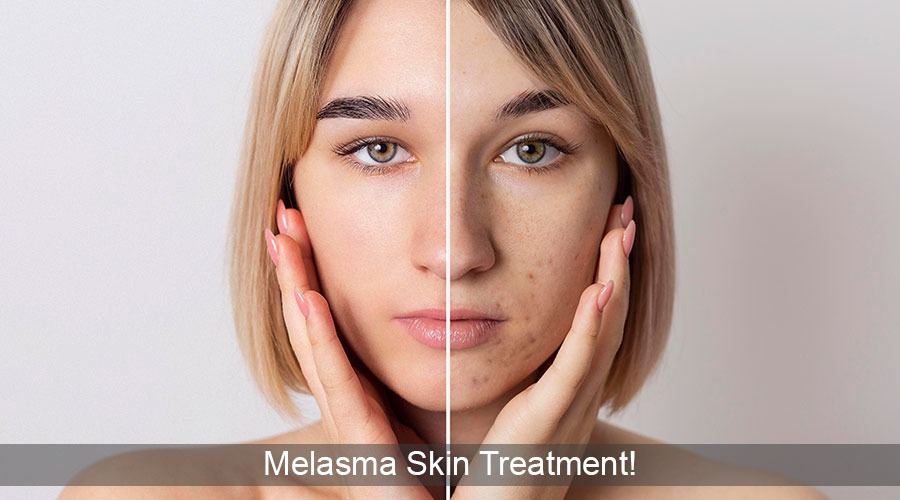A skin disorder called melasma is characterized by brown, blue-gray, or freckle-like areas on the skin. Melasma develops when the cells that determine your skin’s color are overproduced; it is frequently referred to as the “mask of pregnancy.” It is common, and safe, and certain treatments could be beneficial. Usually, melasma disappears after a few months. Why does Melasma appear on the skin?
Melasma is basically a type of discoloration, it usually happens on the face.
Primarily there are 3 main types of Melasma, which include:
1. Center of the face (Centro facial),
2. Cheekbones (malar), and
3. Jawbone (mandibular).
The Centro facial pattern is the most prevalent form of melasma and includes the;
1. forehead,
2. cheeks,
3. upper lip,
4. nose, and
5. Chin.
Types of Melasma
Melasma can have one of four different pigmentation patterns:
Does food affect melasma?
There is no proven study that says that any type of food affects the melasma- Cure or worsens it. However, consider a diet rich in foods containing vitamin D to maintain your skin healthy in general:
1. Epidermal melasma: Excess melanin in the skin’s outermost layers helps to identify epidermal melasma.
2. Dermal melasma: The presence of melanophages (cells that consume melanin) across the dermis is what distinguishes dermal melasma from other types.
3. Mixed Melasma: Dermal and epidermal melasma types are also included in mixed melasma.
4. Excess melanocytes: Dark-skinned people have an excess of melanocytes in their skin
.
Is Melasma permanent?
Melasma is a chronic condition most of the time. This indicates that it is durable (three months or more). Melasma can affect a person for months, years, or life. Melasma may only be temporarily present in some people, such as during pregnancy.
What happens to the skin?
Three layers make up your skin. The epidermis is the top layer, followed by the dermis in the middle, and the subcutis at the bottom. The biggest organ in your body is the liver. It is an organ that accounts for around one-seventh of your total body weight. Your barrier is made of your skin. Your bones, muscles, organs, and everything else are shielded from the elements, bacteria, sunlight, dampness, toxins, injuries, and more. Additionally, it aids in maintaining a healthy body temperature, and guards against dehydration. It allows you to detect sensations like the warmth of a stove, the texture of your dog’s tummy, and the pressure of another person holding your hand.
Melanocytes, which are found in your epidermis, store and create the dark pigment known as melanin. Your skin darkens because the melanocytes create more melanin in response to hormone stimulation, light, heat, UV radiation, or hormonal stimuli.
Melasma is it painful?
Melisma is not harmful. Nothing about it hurts, itches, or is unpleasant.
Which melasma treatments can be done at a doctor’s office?
For various skin types, chemical peels come in a variety of forms and intensities. Every patient should have a customized peel, chosen by the doctor. Peels containing between 30% and 70% glycolic acid are frequently used to treat melasma. Treatments for melasma might include a variety of mixtures, such as a 10% glycolic acid and 2% HQ solution.
We at Glow skin Hair Baner, balewadi, and laser have the best treatment for Melasma. We customize your treatment based on your skin type and texture. We have experts who have been treating cases of Melasma for years.
For more information, you can check our website and for regular updates, you can also follow us on Instagram and Facebook.
Is Melasma permanent?
Melasma is a chronic condition most of the time. This indicates that it is durable (three months or more). Melasma can affect a person for months, years, or life. Melasma may only be temporarily present in some people, such as during pregnancy.
What happens to the skin?
Three layers make up your skin. The epidermis is the top layer, followed by the dermis in the middle, and the subcutis at the bottom. The biggest organ in your body is the liver. It is an organ that accounts for around one-seventh of your total body weight. Your barrier is made of your skin. Your bones, muscles, organs, and everything else are shielded from the elements, bacteria, sunlight, dampness, toxins, injuries, and more. Additionally, it aids in maintaining a healthy body temperature, and guards against dehydration. It allows you to detect sensations like the warmth of a stove, the texture of your dog’s tummy, and the pressure of another person holding your hand.
Melanocytes, which are found in your epidermis, store and create the dark pigment known as melanin. Your skin darkens because the melanocytes create more melanin in response to hormone stimulation, light, heat, UV radiation, or hormonal stimuli.
Melasma is it painful?
Melisma is not harmful. Nothing about it hurts, itches, or is unpleasant.
Which melasma treatments can be done at a doctor’s office?
For various skin types, chemical peels come in a variety of forms and intensities. Every patient should have a customized peel, chosen by the doctor. Peels containing between 30% and 70% glycolic acid are frequently used to treat melasma. Treatments for melasma might include a variety of mixtures, such as a 10% glycolic acid and 2% HQ solution.
We at Glow skin Hair Baner, balewadi, and laser have the best treatment for Melasma. We customize your treatment based on your skin type and texture. We have experts who have been treating cases of Melasma for years.
For more information you can check our skin specialist clinic near me and for regular updates you can also follow us on Instagram and Facebook.
1. Almond milk
2. Eggs
3. Meat
4. Milk
5. Mushrooms
6. Oily fish
7. Orange juice
8. Yogurt

